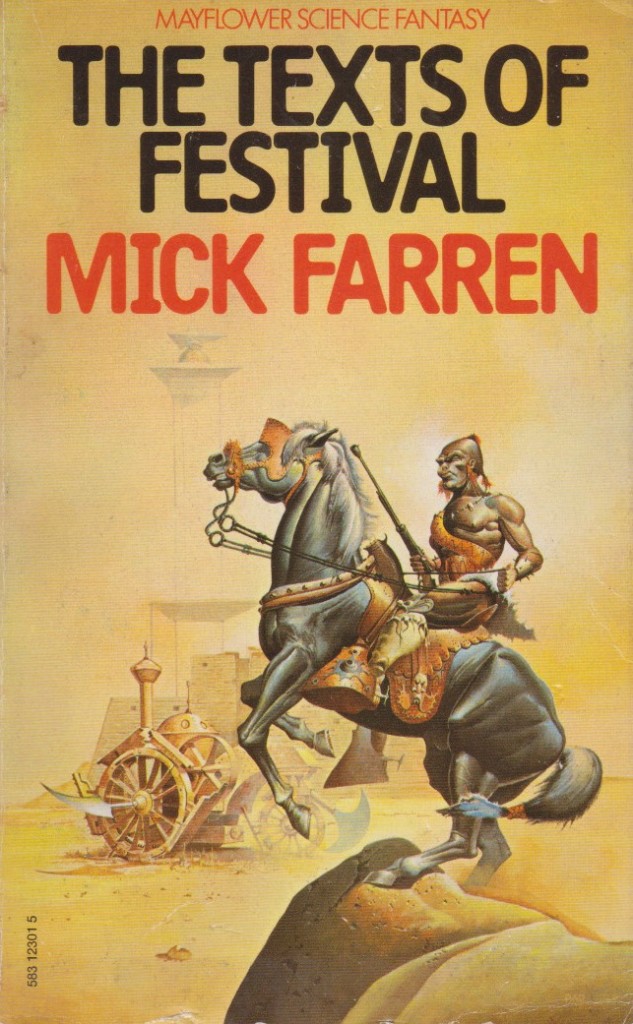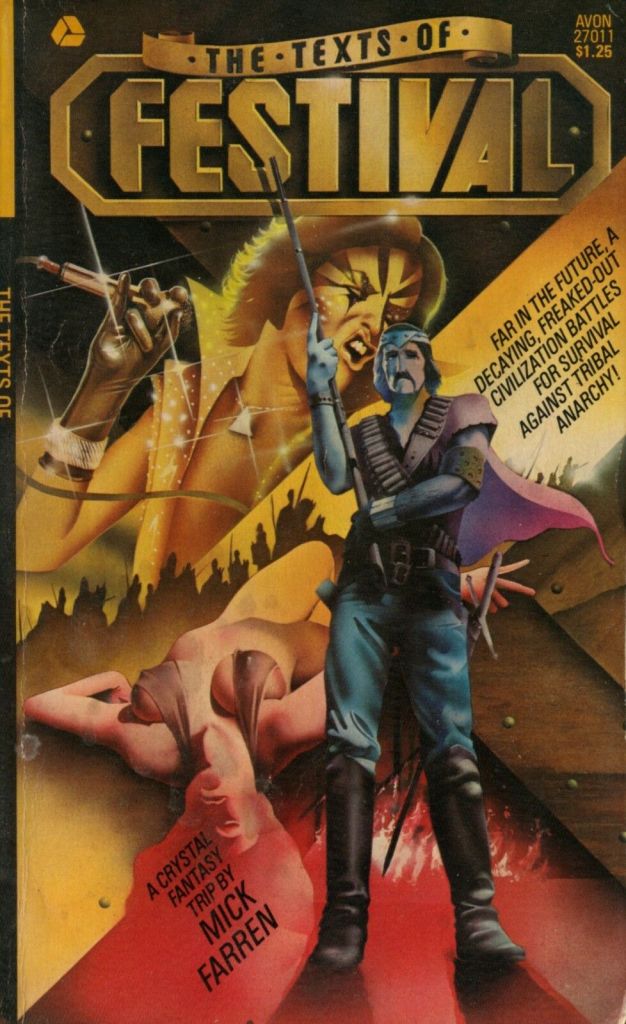(Peter Jones’ cover for the 1975 edition)
2.5/5 (Bad)
Mick Farren (1943-2013)—science fiction author, counterculture musician, underground newspaper journalist—spins a wild drug-tinged adventure, replete with innumerable musical references, across a devastated, decadent, and depopulated future United Kingdom. The Texts of Festival (1973), dolled up with half-baked attempts at philosophy (counterculture becomes mainstream and loses its radical and society-transforming meaning), careens forth with extensive sequences of action-packed exploitative sleaze. A sword-and-fantasy plot unfolds Mad Max style—it’s so easy to forget it’s England not a desert wasteland. The last bastion of civilization, whatever that means, must put aside its decadent ways and fight off barbarian invaders….
If weird 70s British visions of surreal and crumbling landscapes appeal, first check out M. John Harrison’s superior The Committed Men (1971).
Brief Plot Summary/Analysis
A linked series of deaths across a corroded and swampy landscape brings the reader to the slum city of Festival: a bizarre admixture of the American West, Rock-and-Roll, sleazy dive bars, and feudal England. Bullets are currency (15). Lords snort crystal and watch painted women dance. Failed communes, now ruled by corpulent stereotypes of medieval merchants, are drenched in beer and drugs and prostitution. Lyrical fragments of Bob Dylan, the “Prophet Dhillon” (80), and Mick Jagger “the legendary Djeggar, the witch king before the disaster” (79), memorized from old tapes long since frayed and broken, form the gospel justifying the status quo. They are scrutinized for prophetic lines. And bastardized to keep the powerful in power.
A cast of characters—from prostitutes to old heroes—must mobilize against the forces within Festival that refuse to confront the danger lurking over the blasted hills. Iggy, a nihilistic crystal snorting tyrant, joins up with a powerful barbarian tribe and descend on the defenseless Festival. Possessed by a decadent mist that refuses to dissipate, Festival’s inhabitants wait for a “revelation that would save civilization, without even a clear concept of what civilization might mean” (38). Joe Starkweather, now an instrument of Festival’s Lords but a one-time hero who broke the tribes and brought peace, must rev into action and repeat his heroics. Will the communes rise up against the power of the merchants and lords and fight off the danger? Or will one failed society that pretends it’s enlightened be replaced by another that revels in its own decadence?
Final Thoughts
The Texts of Festival is a fast read (2 hours?). The plot is simple. The characters are bland ciphers. The men action-oriented instruments of violence. All female characters are victims (survivors of rape, prostitutes, sex slaves) and objects of lust. Joe Starkweather might bemoan the death of civilization (39) and how “women were reduced to objects again” (94), but Farren revels in cringe-worthy sequences of violence against women and indulges in objectifying descriptions of women.
Also infuriating, some of Farren’s most interesting sequences, for example Lord Valentine’s rituals at Festival’s Stage with mummers “wearing huge grotesque masks” (79) each representing one of 60s/70s musicians whose lyrics are now the gospel, are abandoned mid-scene. Action sequences and orgies drown out the inventive elements of the novel.
I would have quit the book if it weren’t for the references and reworking of counterculture songs and figures. Just as songs serve as vehicles of protest and revolution, Farren speculates that those same songs, detached from their historical contexts, can be used justify authoritarian regimes. Starkweather, the one upright individual in the novel, observes how “the music [the survivors] had brought the the ruins as a means of enjoyment had gradually been adopted as the divine basis of society” (42). There’s a PhD dissertation waiting to be written about 60s/70s SF and song–Suzy McKee Charnas’ masterful Walk to the End of the World (1974) comes to mind.
The references in The Texts of Festival are a fun gloss. But there isn’t much behind the lyrical fragments. If you’re into grime and sleazy 70s pulp, this one might be for you.
(Uncredited cover for the 1975 edition)
(Uncredited cover for the 1st edition)
For additional book reviews consult the INDEX.



Taking a break from the interminable journey of the generation ship!
I wanna crawl back on a generation ship after this one… even as a member of a mid-journey generation! (after I regain my strength I’ll respond to your thought-provoking comment on Simak’s Spacebred Generation).
Ha! Not sure if we can take you back at this point in the journey. You might upset the delicate balance of shipboard automatics and run-away religiosity! 😉
Haha. I’m enjoying the read-through immensely so far.
Even if our next read— A. E. van Vogt’s “Centaurus II” in the June 1947 issue of Astounding Science Fiction, ed. John W. Campbell, Jr.—will probably be the worst so far.
Yeah, I figured this one might have dated quite badly. I haven’t revisited his DNA Cowboys for decades, but I do want to read him again I’ll avoid this one…
I definitely wanted to like this one. And I found the fun use of counterculture references almost rescued the story from the doldrums of bland “defeat the evil invader” narrative… That said, I didn’t mention it in the review, but Farren has a very pessimistic view of humanity. After the failure of the communes, there isn’t a chance at change… There’s the sense that the end described in the story might really be the end. Festival was society’s last chance — and they squandered it.
Well, I guess as a survivor of the sixties counterculture, he probably did feel that the chance for change had passed, as the seventies in this country were full of strikes and conflict, but nothing like the hippie dream. I wish this book had been better, because I would like to have liked it – but I think the violence against and objectification of women would be too much for me.
That is a compelling interpretation. However, I suspect he considered, as an underground journalist and musician, that he was continuing some of the ideals of the movement.
It’s flawed for sure. I’ll probably still tackle The Quest of the DNA Cowboys (1976)… eventually.
I’ve read The Texts of Festival three times now, and though it doesn’t compare with The Quest of the DNA Cowboys, one of his best fictions, I’ve come to very much appreciate Mick Farren’s first novel. Though none of the women are strong characters in the plot of the story, and though most of them are prostitutes, I very much felt that some of them were very strong, distinct characters. The high point of the book for me, which you haven’t mentioned, is that Mick Farren uses a quote from one of his own songs with The Deviants when the religious prophets are trying to decipher a message from the texts, “The outlaws come riding out of the west. On their pale lips are framed words of death.”
Hello Paul, thanks for stopping by and commenting.
Your discussion of female characters does not convince me. I address Farren’s attempt to justify his position in the review (a character commenting that all women have been subjected). However, Farren uses that as an opportunity to depicted them in his exploitative way.
Ah, so, let me get this straight — Farren suggests his own music is prophetic while the music of Dylan and others have been mutilated beyond recognition… That’s a fun, if self-aggrandizing, suggestion. I knew it was Farren’s music but didn’t put it in my review. As I mentioned, the use of musical fragments is the highlight of an otherwise utterly drab story.
I never give up on an author after one book — else I’d dislike a lot of my favorite writers. I’ll explore a few of his other outings eventually.